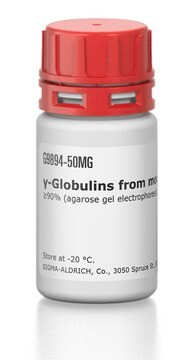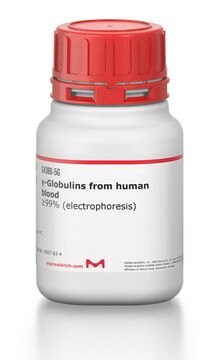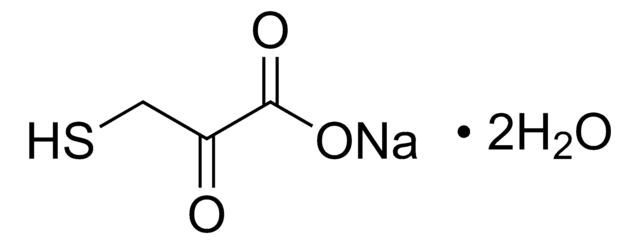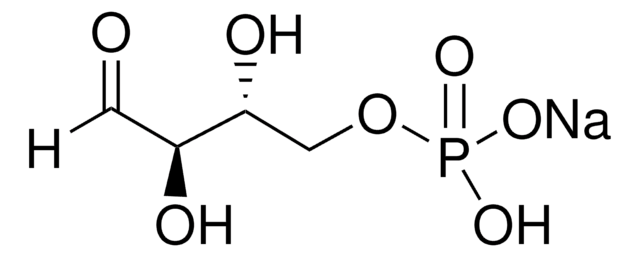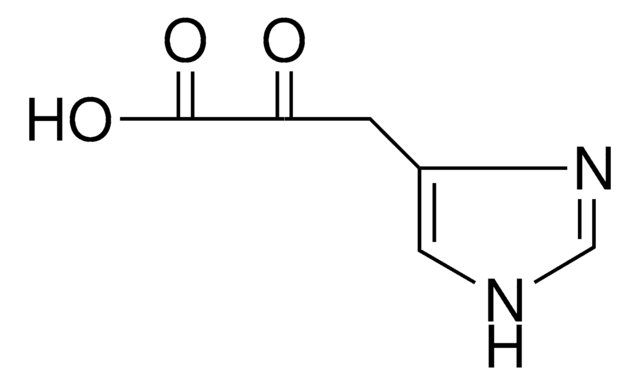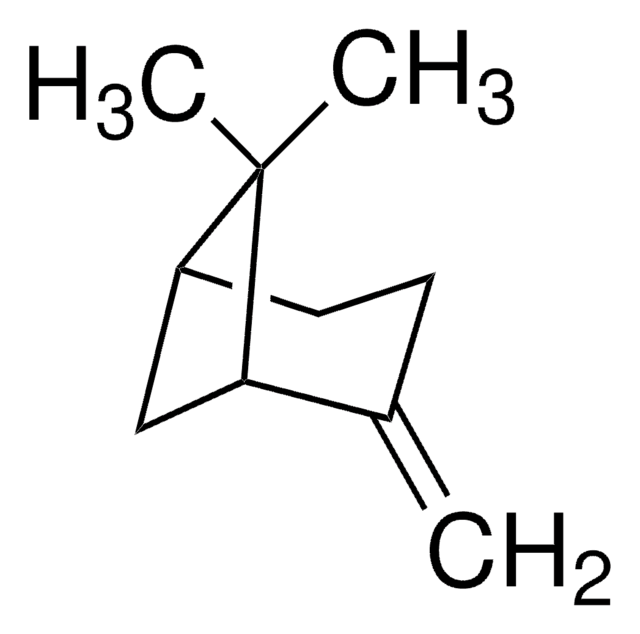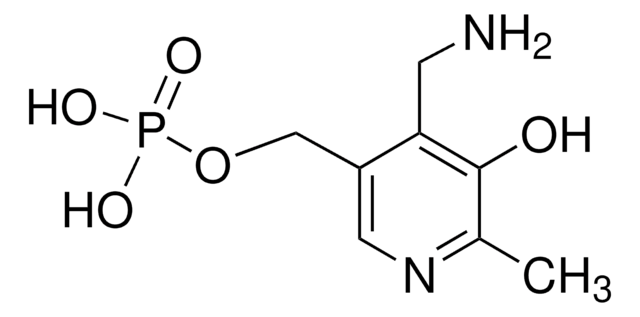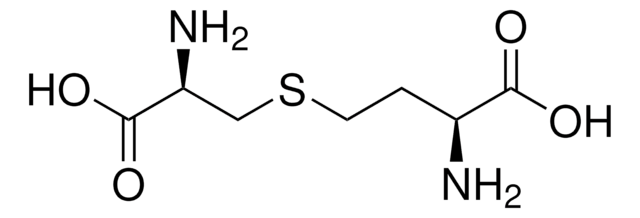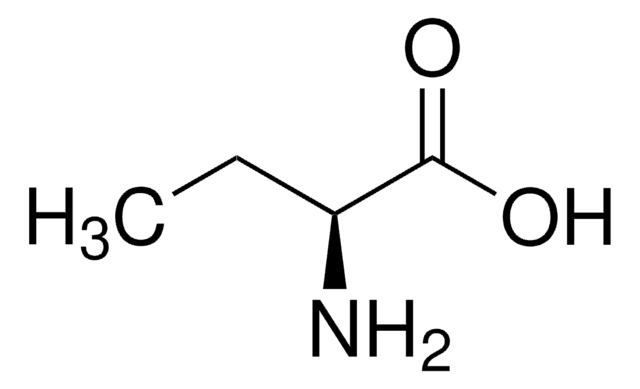Wszystkie zdjęcia(4)
Key Documents
K6000
α-Keto-γ-(methylthio)butyric acid sodium salt
≥97%
Synonim(y):
4-Methylthio-2-oxobutanoic acid sodium salt, 4-Methylthio-2-oxobutyric acid sodium salt, KMBA
Zaloguj sięWyświetlanie cen organizacyjnych i kontraktowych
About This Item
Wzór liniowy:
C5H7O3SNa
Numer CAS:
Masa cząsteczkowa:
170.16
Numer MDL:
Kod UNSPSC:
12352100
Identyfikator substancji w PubChem:
NACRES:
NA.22
Polecane produkty
Poziom jakości
Próba
≥97%
temp. przechowywania
2-8°C
ciąg SMILES
[Na].CSCCC(=O)C(O)=O
InChI
1S/C5H8O3S.Na/c1-9-3-2-4(6)5(7)8;/h2-3H2,1H3,(H,7,8);/q;+1/p-1
Klucz InChI
IFSCKRWNXKWTLR-UHFFFAOYSA-M
Powiązane kategorie
Opis ogólny
α-Keto-γ-methylthiobutyric acid (KMTB) is a keto derivative of L-methionine that shows considerable potential as a substitute for L-methionine. The sodium salt of KMTB can be employed in nucleophilic substitution reactions. Additionally, it acts as a building block for the synthesis of amino acids, peptides, and other complex organic compounds.
Zastosowanie
- Measuring antioxidant capacity using the ORAC and TOSC assays.: This study details the use of α-Keto-γ-(methylthio)butyric acid sodium salt in assessing antioxidant capacity through ORAC and TOSC assays, emphasizing its utility in metabolic and chemical synthesis research (Garrett AR et al., 2010).
This page may contain text that has been machine translated.
Hasło ostrzegawcze
Warning
Zwroty wskazujące rodzaj zagrożenia
Zwroty wskazujące środki ostrożności
Klasyfikacja zagrożeń
Eye Irrit. 2 - Skin Irrit. 2 - STOT SE 3
Organy docelowe
Respiratory system
Kod klasy składowania
11 - Combustible Solids
Klasa zagrożenia wodnego (WGK)
WGK 3
Temperatura zapłonu (°F)
Not applicable
Temperatura zapłonu (°C)
Not applicable
Środki ochrony indywidualnej
dust mask type N95 (US), Eyeshields, Gloves
Wybierz jedną z najnowszych wersji:
Masz już ten produkt?
Dokumenty związane z niedawno zakupionymi produktami zostały zamieszczone w Bibliotece dokumentów.
Klienci oglądali również te produkty
Rebecca Piccarducci et al.
Antioxidants (Basel, Switzerland), 8(11) (2019-11-14)
The allele epsilon 4 (ε4) of apolipoprotein E (ApoE) is the strongest genetic risk factor for Alzheimer's disease (AD). ApoE protein plays a pivotal role in the synthesis and metabolism of amyloid beta (Aβ), the major component of the extracellular
Ryan N Dilger et al.
The Journal of nutrition, 137(8), 1868-1873 (2007-07-20)
Relative bioefficacy and toxicity of Met precursor compounds were investigated in young chicks. The effectiveness of DL-Met and 2-keto-4-(methylthio)butyric acid (Keto-Met) to serve as L-Met precursors was quantified using Met-deficient diets of differing composition. Efficacy was based on slope-ratio and
Simona Daniele et al.
Frontiers in aging neuroscience, 10, 17-17 (2018-02-15)
The loss of protein homeostasis that has been associated with aging leads to altered levels and conformational instability of proteins, which tend to form toxic aggregates. In particular, brain aging presents characteristic patterns of misfolded oligomers, primarily constituted of β-amyloid
Gary W Winston et al.
Comparative biochemistry and physiology. Toxicology & pharmacology : CBP, 139(4), 281-288 (2005-02-03)
During embryogenesis in grass shrimp the capacity to scavenge oxyradicals increased as measured by the Total Oxyradical Scavenging Capacity (TOSC) assay. The increase in TOSC during embryogenesis was associated with increasing concentrations of a number of antioxidants, including coenzyme Q
Manas K Chattopadhyay et al.
Proceedings of the National Academy of Sciences of the United States of America, 102(45), 16158-16163 (2005-11-02)
Methylthioadenosine is formed during the biosynthesis of spermidine and of spermine and is metabolized by methylthioadenosine phosphorylase, an enzyme missing in several tumor cell lines. In Saccharomyces cerevisiae, this enzyme is coded by the MEU1 gene. We have now studied
Nasz zespół naukowców ma doświadczenie we wszystkich obszarach badań, w tym w naukach przyrodniczych, materiałoznawstwie, syntezie chemicznej, chromatografii, analityce i wielu innych dziedzinach.
Skontaktuj się z zespołem ds. pomocy technicznej